Mirror, mirror, on the wall, why aren’t you the fairest of them all?
Sadly, self-cleaning mirrors remain a figment of our imagination. But don’t fret! The magic of a sparkling mirror isn’t out of reach.
You can easily banish smudges and streaks with just a glass cleaner and a trusty microfibre cloth.
So, don’t let a cloudy mirror dull your shine. Dive in to discover how a few simple steps can transform your mirrors from grimy to gleaming.
Why Is It Important to Clean Mirrors?

Simply put, clean mirrors reflect light more effectively so you can see yourself clearly. Wow, that’s a lot of adverbs.
Regular cleaning also prevents the buildup of grime and bacteria, especially in high-humidity areas like bathrooms.
How Often to Clean Mirrors
Bathroom mirrors can use a daily wipe because of all the moisture and products they are exposed to.
Bedroom and vanity mirrors are less demanding. Depending on how often they’re used, they may need cleaning once or twice a week.
Don’t let dust collect on decorative mirrors. Just because they’re sitting still and not used as often, you still need to wipe them once a week.
The Best Tools for a Streak-free Mirror
Ditch the paper towels and newspapers. More often than not, they leave behind lint and streaks on mirrors.
You only need a good-quality glass cleaner and a clean microfibre cloth to clean your mirror.
Professional cleaners recommend using one of the following solutions to clean mirrors:
- Windex
- Baking soda
- White vinegar
- Rubbing alcohol
- Koala Eco’s Natural Glass Cleaner
The Best Ways to Clean a Mirror
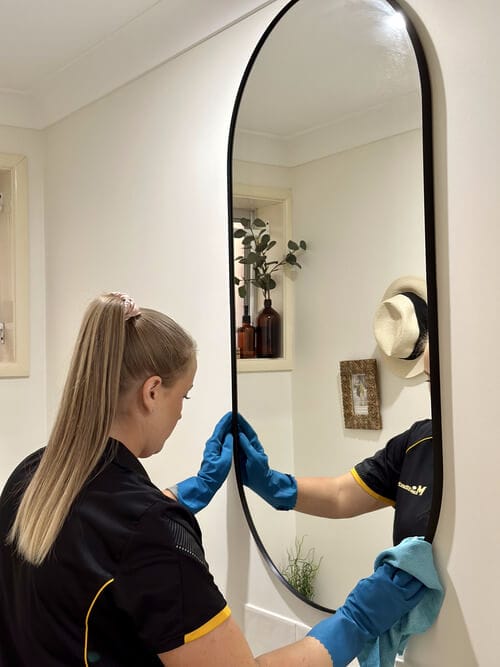
Before diving into cleaning the mirror glass, let’s clean its frame. Ignoring this step means transferring dirt and debris onto your freshly cleaned mirror.
Give your mirror frame a quick once-over with a damp microfibre cloth, then move on to cleaning that shiny surface.
There’s more than one mirror cleaning method – choose the option that best suits you.
How to clean a mirror with Windex
Windex is a commercial cleaner in a spray bottle that you can easily buy from your local stores.
Spray a little Windex onto a clean microfibre cloth and wipe on your mirror until streaks and dirt are gone.
You won’t need to rinse the mirror after cleaning it with Windex. Its formula is made to evaporate quickly and leave the surface streak-free.
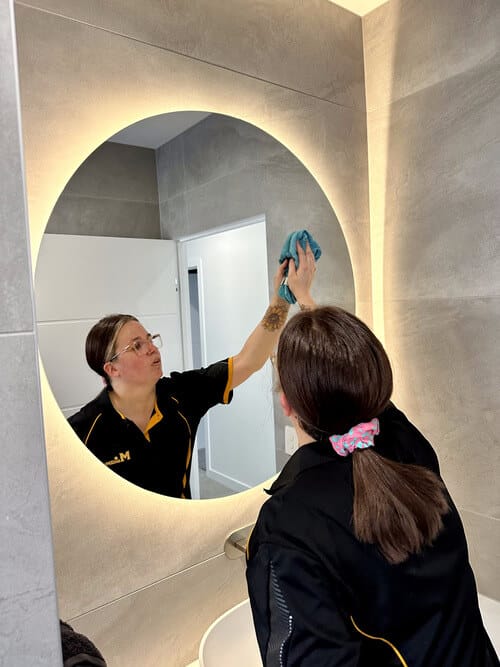
How to clean a mirror with baking soda
If your mirror has tough stains, it’s time to bring out the big guns – baking soda.
The best thing about baking soda is it’s gentle on glass but tough on stains.
Make a paste of baking soda and a bit of water. Apply it to the mirror stains and let it sit for at least five minutes.
Gentle wipe it off with a damp microfibre cloth and admire your reflection in a stain-free mirror.
How to clean a mirror with white vinegar
If you’d rather not buy glass cleaners, white vinegar is a powerhouse for general cleaning and works wonders for your mirror.
Mix equal parts white vinegar and water in a spray bottle.
Spray the white vinegar solution onto a clean microfibre cloth and wipe your mirror in a zigzag motion.
Note: The vinegar smell will naturally subside once the mirror surface dries up.
How to clean a mirror with rubbing alcohol
Rubbing alcohol is great for a quick yet deep clean. Spritz a bit of rubbing alcohol onto a clean microfibre cloth, then wipe the mirror in a zigzag motion.
Focus on any spots or stains, but don’t rub too much. You might scratch the glass.
Much like Windex, rubbing alcohol is formulated to evaporate quickly and leaves no streaks or residue.
How to clean a mirror with Koala Eco Glass Cleaner
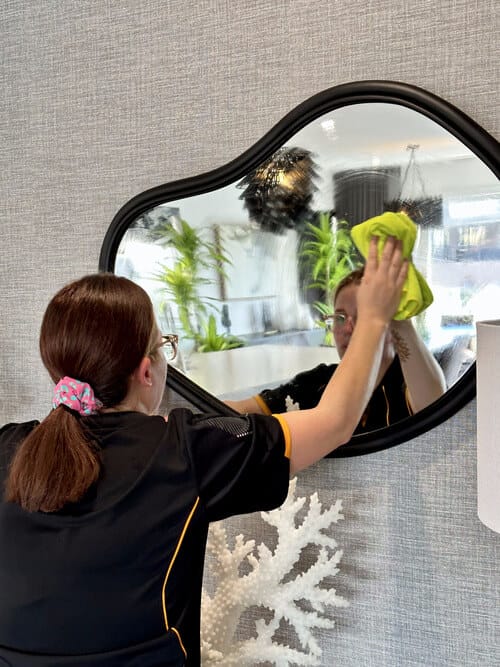
Remember how we mentioned using a high-quality glass cleaner? You don’t have to settle for a commercial one, especially if you’re keen to start a sustainable and eco-friendly lifestyle.
Begin by lightly misting Koala Eco natural glass cleaner directly onto the mirror surface.
This product harnesses the power of natural ingredients, making it safe for your home while being tough on dirt and grime.
With a clean, dry microfibre cloth, gently wipe the mirror in a circular motion to spread the cleaner evenly. Continue wiping, transitioning to vertical and then horizontal swipes to cover all areas.
Use another microfibre cloth to buff the mirror to a brilliant shine.
How to Clean a Mirror With Hard Water Stains
Cleaning hard water stains requires a bit more elbow grease than wiping cleaning solutions and letting them dry.
White vinegar comes to the rescue again; this time, you’ll use it with baking soda.
Mix equal parts of white vinegar and water in a spray bottle. The acidity in the vinegar helps dissolve the mineral deposits that hard water leaves behind.
Spray the mixture onto a clean microfibre cloth, and then wipe it onto the stained areas of the mirror.
Let the solution sit for 5 to 10 minutes, allowing it to break down the hard water stains.
If the stains are particularly stubborn, you might need to apply the vinegar solution directly onto the stains and rub it in with a clean cloth.
After the white vinegar solution works on the hard water stains, wipe the mirror with a different microfibre cloth to buff it.
How to Clean a Foggy Mirror

Mirrors get hazy or cloudy from time to time simply because of a lack of maintenance.
But in some cases, desilvering or black tarnishes and spots can make your mirrors look foggy.
This happens when moisture seeps into the backing or silver layering of your mirror.
Start by mixing a solution of equal parts water and white vinegar in a spray bottle. This mixture cuts through the film, causing the foggy appearance of a mirror.
Unlike the previous cleaning options, you will need to spray the white vinegar solution directly (and liberally) onto the surface of the mirror.
Use a clean, soft microfibre cloth to wipe the mirror in a circular motion. The white vinegar should dissolve any buildup that’s causing the foggy look.
After wiping with the vinegar solution, take another clean microfibre cloth, buff the mirror to dry it completely, and bring out a streak-free shine.
If the mirror is still a bit foggy, repeat the process or slightly increase the vinegar concentration for a stronger cleaning solution.
How to Clean Old Mirrors
Old mirrors are mostly layered out of silver, lead, or mercury, so cleaning them warrants extra care.
First, prep a mild cleaning solution by mixing one part distilled water with one part white vinegar in a spray bottle.
Alternatively, for really delicate antique mirrors, you can just use distilled water to minimise the risk of damage.
Spritz the solution onto a soft, lint-free cloth or microfibre cloth to prevent the liquid from seeping into the edges of your mirror.
Gently wipe the mirror’s surface with the damp cloth, taking care not to apply too much pressure.
Focus on areas with visible dirt or marks, but be careful around any cracked or damaged areas.
After cleaning, use another microfibre cloth to carefully buff the mirror and restore its shine.
Mirror Cleaning Tips and FAQs
Mirror, mirror on the wall. Show me everything, show it all!
Why do bathroom mirrors get dirty so fast?
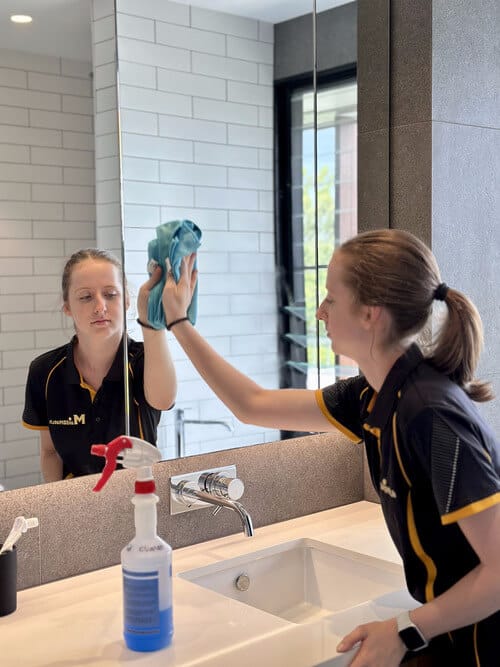
Bathroom mirrors get dirty fast because of exposure to water splash and moisture.
Products like shampoo, toothpaste, hairspray, and aerosols build up stains, too.
These sticky residues can make your mirror look foggy and difficult to clean over time.
How do you keep a mirror shiny?
To keep your mirror shiny and lint-free, it’s recommended to clean it regularly with mild cleaning products or household products like vinegar or baking soda.
Using harsh products and inappropriate cleaning techniques can result in black tarnishing or spots on your mirror.
How do you clean a mirror without streaks?
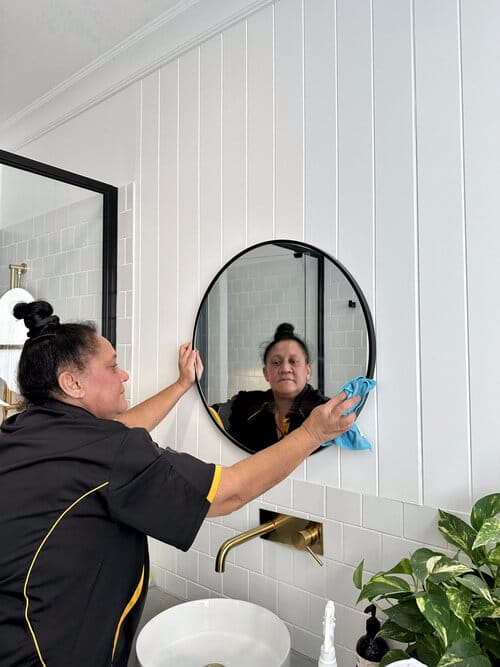
One important step in cleaning your mirror without streaks is to use a microfibre cloth instead of paper towels or newspapers.
Another tip is to wipe your mirror in a zigzag or tight S-like pattern, especially if you’re using vinegar or rubbing alcohol.
How do you clean a mirror without vinegar?
Cleaning mirrors with white vinegar will give off an unpleasant smell, but it’s the best at cleaning practically anything.
Of course, you can use rubbing alcohol, baking soda, Windex or another good-quality commercial glass cleaner instead.
Can I clean a mirror with shaving cream?
Yes, but it can be messier than using baking soda or white vinegar.
Here’s how to do it:
- Use your hand or a clean cloth to spread a thin layer of any standard shaving cream over the surface of the mirror. You don’t need a lot of it, just enough to cover the glass evenly.
- Wipe off the shaving cream with a clean, dry microfibre cloth or towel.
Some folks swear that this trick defogs bathroom mirrors for a few weeks. Just be sure to use a soap and scent-free shaving cream.

